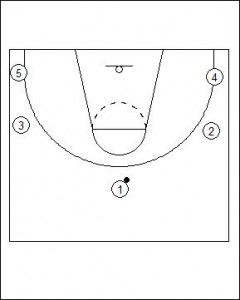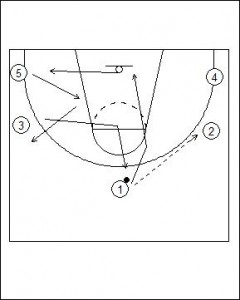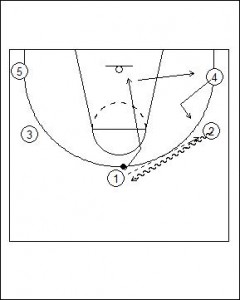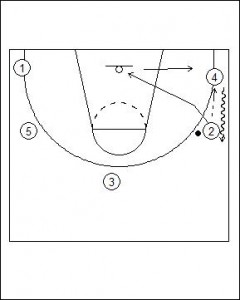Introduction to the Open Post Offense
The Open Post Offense or as it is also know 5-Out Offense follows fundamental motion offense principles. The set-up for the offense starts with all five offensive players outside the three-point line or at least outside the keyway. The noticeable visual aspect of the Open Post Offense is the space and freedom for player movement through the keyway.
While motion offense origin has been disputed, Hank Iba, the former Oklahoma State Cowboys Head Men’s Basketball Coach is often highlighted as one of the first coaches to use the principles. The Open Post Offense became popular with teams like Oklahoma State University and Indiana University utilising the system.
The Open Post Offense’s pivotal focus is on the proper use of space. This has an effect of spreading out the defense players. When there is good ball movement, player movement, a selection of different ‘reads’ the result is a free-flowing and “unrestricted” offense. By not having a fixed post player the Open Post Offense allows all players to move into post positions and possibly exploit a miss match. Characteristics of teams using the Open Post Offense are quick, skilled, undersize, and do not have an inside dominance presence.
Additionally the Open Post Offense can be used as a stalling tactic to slow the speed of play and therefore controlling the tempo of the game.
The Open Post Offense requires that all five players can shoot from the perimeter or at the very least from outside the keyway. Failure to be able to shoot from range will result in defensive players being able to help from closer positions which inhibits the creation of space the offense needs to be successful. As a result of all the players moving through a range of positions and executing various two-player tactics (e.g. pick and roll) all players must be competent in the full range of fundamental skills. Without this players will be limited in what ‘reads’ they can make and randomly utilize depending on the situation.
While following motion offense principles and instilling ‘reads’ into scenarios for players the Open Post Offense can also be combined with set plays. An example might be that if no shot has presented itself with five seconds left on the shot clock that the closest player sets an on-ball screen for the ball handler.
When playing against a team using the Open Post Offense your best defensive strategy is to look at each player individually. Most teams will not have five players competent in the broad range of skills or shooting range demanded to perform the offense proficiently. Break down these weaknesses player by player to paint a picture of how to guard each player. If an offensive player cannot shoot from the perimeter, this will allow your defensive player to play in a stronger help position. Each technical skill of each offensive player needs to be broken down and analysed.
Another option if the team you are playing against does not have a strong perimeter shooting offensive line-up is to utilize a zone defence.
The example of the introduction of the Open Post Offense will be focused on the use of the Pass, Cut and Replace (give and go) tactical movement.

All five players take a spot outside the 3 point line.
The formation can be varied to have a two guard front, but for this example we will focus on a single player in the point position (One). Two offense players take the foul line extended (Two and Three) and the final two offense players take the long corner (Four and Five).

Movement from a Weak Side Cut
One (1) passes the ball to Two (2) and then cuts to the basket before moving to the weak side long corner.
The weak side players replace to the middle of the floor (Three and Five).
Before moving to fill the vacant position closer to the ball on the perimeter Three (3) and Five (5) should consider a cut to the basket or possible receiver spot for scoring opportunity.

Movement from a Strong Side Cut
If One (1) decided to cut and move to the strong side of the floor (ball side), then Two replaces the position left open by the cutter (One). This is done through Two (2) using a dribble to fill the vacant position.
Four (4) replaces position left open by Two (2).

When the ball is at the foul line extended position (Two) and the ball is passed back to the point position (middle of the floor). The cutter (Two) moves to the basket and then replaces to the same side of the floor.
The player in the long corner on the same side of the floor (Four) fills the now vacant position.

Variation on Pass to Middle
If the cutter (Two) decides to continue cut onto the long corner on the weak side of the floor. Then there are a number of options that can occur.
The diagrammed rotation has the player in the point Position (Three) dribble to replace the now vacant cutters spot (Two).
Weak side players (Five and One) replace spots now vacant as a result of the cutters movement and dribbler rotation (Three).

Player movement on Pass to Corner
If Two (2) passes to the strong side long corner the player cuts to the basket.
Players (Three, Five and One) then rotate one position closer to the ball in the corner.
Rotating players should always consider a cut to the basket or possible receiver spot for scoring opportunity.

Variation on Pass to Corner
If Two (2) passes to the strong side long corner the player cuts to the basket. But decides to replace back to the strong side of the floor then a dribble can be used.
Four (4) dribbles into the now vacant cutter spot on the perimeter.
This combination it’s particularly suitable against zone defenses and match up defenses.
The examples provided here in regards to basic movements are only a very small sample of the endless possibilities within the Open Post Offense. As with any motion based offense, specific rules can be included by individual teams to meet their needs.
Being able to utilise the Open Post Offense effectively for coaches will take considerable research and time to develop a familiarity in regards to what options are available and work to your team’s strengths while hiding the team’s weaknesses.







This really answered my drawback, thanks